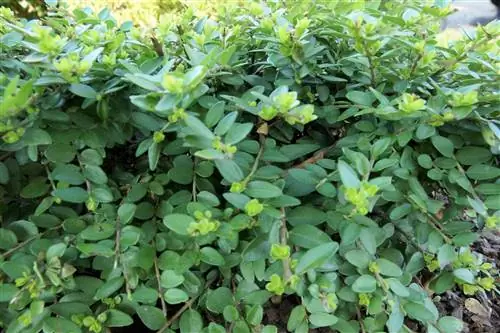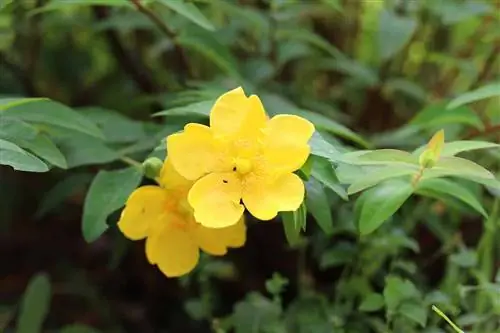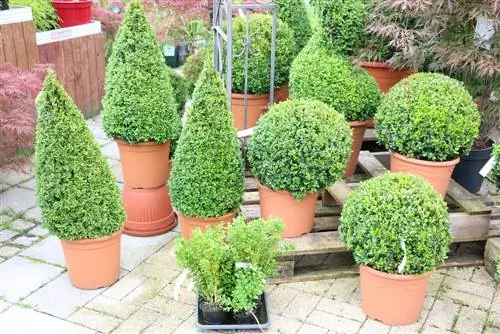- Author admin [email protected].
- Public 2023-12-17 03:39.
- Last modified 2025-01-24 12:45.
Lonicera nitida, the evergreen honeysuckle from the honeysuckle family, provides fresh greenery in the garden all year round with its leaves. The small shrub, which, depending on the variety, can grow to a maximum height of 100 cm and a width of up to 80 cm, is often used as a boxwood substitute. Many hobby gardeners regularly cut it into shape so that the bushes become hearts, balls or animals, depending on their preferences. It is very easy to care for and also likes to be kept in a pot.
Plants
Since the evergreen honeysuckle is very spreading, around 4 to 5 plants per m are sufficient for a dense hedge. For embankments, 5 to 7 plants per m² are recommended. To do this, dig a planting hole for each plant that is approximately twice as deep and twice as wide as the plant's root ball. Loosen the roots in the ball of the pot and water them a little in a bucket of water. Then place the hedge myrtle in the planting hole and fill it with humus-rich substrate so that the plant grows well. Water the plants well!
Location
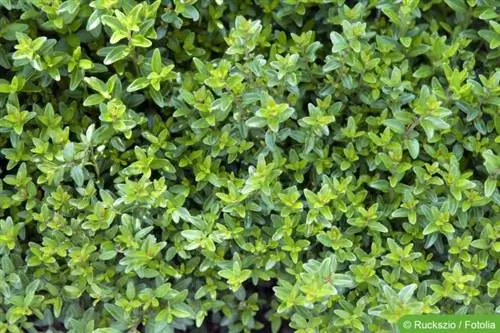
Lonicera nitida thrives best in sunny locations, but also does well in the shade. In addition to its use for small hedges or as a topiary, it is also often used as a background plant for perennial beds.
Substrate
The myrtle grows best in a humus-rich, well-drained and nutrient-rich substrate. Basically, it has hardly any demands and can therefore cope with all other types of soil. The substrate should not be too moist. When planting in a pot, conventional pot plant soil is well suited, which is loosened up slightly with clay granules.
Tip:
Always make sure that there is no waterlogging. If the soil at the location is too clayey, add gravel or coarse sand to the lower third of the planting hole as drainage. A drainage layer, for example made of pumice gravel or clay granules, should also be placed in the bottom layer of the bucket. And the bucket should have drainage holes that are covered with small pieces of pottery so that the holes do not become clogged with substrate.
Pouring
Evergreen honeysuckles require regular watering, especially during the growing season. The plants don't mind occasional drying out. However, during longer dry periods they need good watering so that they are not weakened too much.
Tip:
Do not water until the top layer of soil has dried, both when planting in a container and when planting in the garden.
Fertilize
Start fertilizing the purchased honeysuckle one year after planting at the earliest. You can fertilize plants you have grown yourself using cuttings with good compost right from the start. Provide potted plants with commercial liquid fertilizer every 4 to 8 weeks in spring and summer.
Cutting
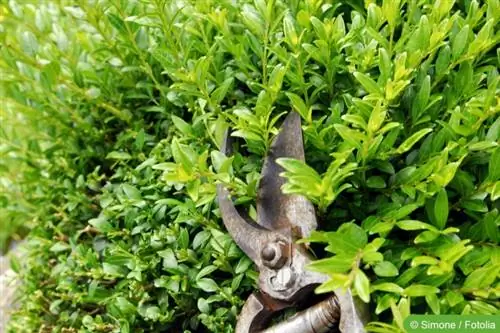
Lonicera nitida tolerates pruning well and is cut by many hobby gardeners after flowering in early summer. If you like, you can also let the small purple berries that form from the fragrant flowers ripen. The birds really like the berries as food in winter. However, they are slightly poisonous to humans!
Since the myrtle grows quickly in width and height, it can also tolerate radical pruning at the end of the winter. The more the evergreen honeysuckle is cut, the better it branches and the denser and more compact it grows. Many hobby gardeners also like to use them as wall plants. If the hedge myrtle gets out of shape, it is simply trimmed.
- Always work with sharp and germ-free cutting devices
- no branches are allowed to tear
- otherwise entry points for pathogens can arise
Tip:
You can make topiaries for hearts or other shapes at any time of the year, including at the end of winter.
Wintering
The evergreen honeysuckle is very frost hardy and can tolerate -15° to -20° C depending on the variety. To prevent drying damage during so-called cold frost periods, it must also be watered on frost-free days in winter. It's best to water the plants thoroughly again before winter comes. A place on the wall of the house is ideal for overwintering the Lonicera nitida in a bucket. If some shoots freeze, they are simply removed in spring. The hedge myrtle sprouts again without any problems.
Propagate
Cuttings are usually used to propagate the evergreen honeysuckle. These can, for example, be cut from cuttings as shoots or head cuttings during regular topiary cutting in summer. The shoots should already be slightly woody. The shoot cuttings should be approximately 15 to 18 cm long and the top cuttings 5 to 8 cm long. Head cuttings are cuttings that are cut from the end of the shoot, while shoot cuttings are taken from the rest of the shoot. Remove all but 3 pairs of leaves from each cutting and cut the lower end of the cutting diagonally. Then place the cuttings with the diagonally cut end in small pots with potting soil or directly in a growing bed in the garden.
You can place the pots in a sheltered place in the garden or store them in the greenhouse or winter garden. Then overwinter the small plants frost-free for at least 1 year before they are moved to the intended location.
Diseases and pests
The evergreen honeysuckle is a very robust plant and is actually hardly affected by diseases or pests. Spider mites can only be infested when growing cuttings in the winter garden or greenhouse. However, you can get rid of these stubborn, sucking animals with the help of predatory mites or neem preparations in the greenhouse.
Neem preparations with neem seeds or neem oil are also suitable in the winter garden - but only after you have rinsed the affected plants or cuttings in the growing pots with water. This is best done in the bathtub or on the lawn or terrace with a garden hose. The undersides of the leaves should also be rinsed. To prevent the soil from being washed out of the pots, it is best to pack them in foil bags.
Tip:
Check the small plants regularly in the following weeks for spider mite infestation and repeat the procedures if necessary.
The variants of the evergreen honeysuckle
If you choose the Tatar honeysuckle, you get a plant that is particularly adaptable. Whether it is placed in a sunny or shady location plays a minor role for it, as it can adapt optimally to both conditions. The Tatar honeysuckle can reach a height of up to four meters.
When in bloom it produces beautiful pink flowers that are a real feast for the eyes. The developed berries shine a strong red tone from July to August. They are poisonous to humans, but songbirds love them very much. The Tatar honeysuckle can also be used for underplanting.
Tip:
When fully grown, the plant can even tolerate strong sunlight, urban climates or harsh climates and shade without any problems.
The red honeysuckle, which many know as the common honeysuckle, is also a representative of the evergreen honeysuckle. It is particularly frequently visited by butterflies, making it ideal if you want to observe many butterflies in the summer months.
The red honeysuckle is resistant not only to strong sunlight and drought, but also to road s alt. In winter the honeysuckle can be described as bare, but in spring it continues to grow new shoots. The red honeysuckle should be planted on a very calcareous soil and reaches a height of up to three meters.
The honeysuckle, on the other hand, blooms from December to March. It got its name because of the scent it produces, which is reminiscent of the sweetness of honey. However, the variant also known as sweet-smelling honeysuckle can suffer frost damage, especially if the winter was very long and hard. In this case, the cut must be made.
Conclusion
The Lonicera nitida is a densely branched, evergreen shrub or ground cover, depending on the variety. The plants grow widely, making them ideal for greening larger areas and slopes, but also look great as small hedges in the garden. The shrub, also known as hedge myrtle, is a robust and disease-resistant alternative to boxwood and can be cut to shape just as easily.

